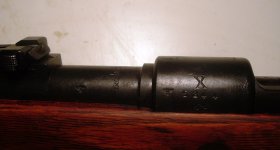Most of the salvaged parts and armorers spare parts you see on 98k's came from the evacuation of the Posen depot system, where there were tons of salvaged components and spare parts. There were some documents recently found about German plans to destroy the facilities and such, nothing as far as I know about where parts were sent.
The Heereszeugamt H.Za. Posen had a large Waffenwerkstatt (weapon workshop), in addition at the Heeresnebenzeugamt H.N.Za. Posen was a highly expanded part of the weapon workshop.
On August 4, 1944, the management of the H.Za. Posen was ordered by Feldzeugkommando XXI to set up an evacuation calendar. The evacuation calendar should be prepared in case an evacuation would become necessary in the future, therewith this can be done quickly by preparatory measures. The evacuation calendar must contain:
a.) The stocks to be evacuate were listed according to an urgency level from 1 to 5. As example fully serviceable weapons and repairable weapons was at level 1, barrels and bolt parts at level 2.
b.) The course of the evacuation in 5 paragraphs with all details. As example schedule of the supervisory staff, schedule of the labor and means of transport etc.
Another document shows, the relocation are sorted by Geräteklassen (device classes) and the parts should be sent to different locations in the area of Feldzeugkommando III. Here is a list of Geräteklassen:
device classes
As example Geräteklasse J (Infanteriegerät - Infantry equipment), in this case small arms and spare parts, should be send to H.Za. Spandau (Bezirk 2a) - Gl. Küstrin Neustadt. ***
Geräteklasse A (Artilleriegerät - Artillery equipment) should be send to H.Za. Spandau (Bezirk 4a) - Berlin-Spandau (Johannisstift) Zeugamt area.
*** In the city Küstrin was located the Heeresnebenzeugamt H.N.Za. Küstrin and I had to think about the "Kü" and "Ku" marking (I just mention it, we know the "Kü" marking belong to Küpper bei Sagan).
On January 23, 1945 Posen had the first enemy contact with the Russians. I still have to evaluate many documents, before I can write more about it.







